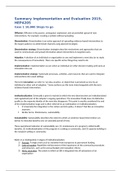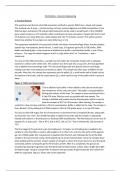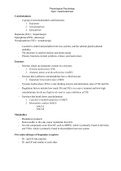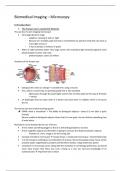Summary of the course by week – based on required literature and lectures.
(Week 4 and 8 are exam weeks where no new information is covered).
Week 1 – Conceptual Models & Analysis of Variance 2
Week 2 – Interaction & Factorial ANOVA 3
Week 3 – Regression Basics 5
Week 5 – Regression Complications & Mediation 7
Week 6 – Logistic Regression & Hypothesis Formulation 9
Week 7 – Principal Components Analysis & Reliability Analysis 12
, Quantitative Data Analysis 2
Week 1 – Conceptual Models & Analysis of Variance
P-value
• Probability of obtaining a result (or test-statistic value) equal to or “more extreme”
than what was actually observed, assuming that the null hypothesis is true.
• Looking for a small p-value so that the null hypothesis is unlikely
Moderator = variable moderates (changes) the relationship between two other variables
(One-Way Independent) ANOVA to test whether statistically significant differences exist in scores on a
quantitative OV between different levels (groups) of a categorical PV.
Number of Categories
2 2 or more
Different respondents
(independent samples) Independent Samples T-Test (One-Way Independent) ANOVA
(between subjects)
Same respondents
(dependent samples) Paired Samples T-Test (One-Way) Repeated Measures ANOVA
(within subjects)
Independent Samples T-Test (One-Way Independent) ANOVA
• One OV quantitative • One OV quantitative
• One PV categorical • One PV categorical
o 2 categories o 2 or more categories
o Participants = different o Participants = different
ANOVA Assumptions Levene’s Test
• Homogeneity of group variances • Homogeneity of variances?
• Residuals are normally distributed • H0: assumed variances are equal
• Groups are roughly equally sized (equal • Therefore, we want a large p-value so we
cell sizes) do not reject H0
o p-value > α = 10%
Unequal Variances Robust tests of equality of means: Brown-Forsythe and/or Welch
F-Test: F-ratio = (explained variability / unexplained variability) = (between groups / within groups)
• H0 : μ1 = μ2 = … = μi
o No differences in OV mean across the different categories of PV
o No significant difference between group means
• H1: at least one μ differs
o There is at least one difference in OV mean score between PV categories
• (We want a big F-Ratio more explained variability)
ANOVA decomposes total variability observed in OV
• Variability caused by differences between groups explained variation; model sum of squares
• Variability caused by differences within groups unexplained variation; residual sum of squares
R2 : Proportion of total variance in our data that is “explained” by our model
• R2 = explained variability / total variability
• Percentage of variance in OV explained by PV(s)











